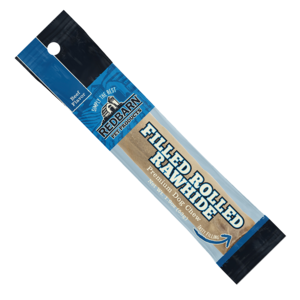Redbarn Filled Rolled Rawhide Beef Flavor Review
PawDiet has been helping pet owners since 2015. To fund our efforts, articles may include affiliate links; if you buy something through a link, we may earn a commission.
Review of Redbarn Filled Rolled Rawhide Beef Flavor
According to our most recent data, this product is intended for intermittent or supplemental feeding only.
Review of Ingredients
In our review of Redbarn Filled Rolled Rawhide Beef Flavor, we'll examine all 14 ingredients and highlight the nutritional contribution of each ingredient.
While the first few ingredients typically dominate the recipe's composition, ingredients in small quantities can still have a meaningful impact on the overall nutritional profile of the recipe.
While rawhide itself isn't a nutrient source, it serves as a chewable material that can aid in dental health by helping to clean your dog's teeth and gums. It should be offered under supervision due to potential choking risks.
Corn syrup is a sweetener that provides a quick source of energy, though it should be consumed in moderation due to its high sugar content.
Beef broth is a flavorful and hydrating ingredient that adds moisture to your dog's food, making it more appealing and easier to digest. It also provides essential nutrients and can help support overall health and well-being.
Chicken meal is a highly concentrated source of protein made from dehydrated and ground chicken. It provides essential amino acids for your dog's muscle development, tissue repair, and overall growth, making it a valuable ingredient for maintaining your dog's health and well-being.
While sugar can be found in small amounts in some dog food recipes, it is not considered an essential ingredient for dogs. Excessive sugar consumption can contribute to weight gain, dental issues, and other health problems in dogs. It is essential to provide a balanced diet with limited added sugars.
Beef Fat (preserved with mixed tocopherols) is a source of energy and fat-soluble vitamins, and tocopherols help keep the fat fresh and rancid-free.
While salt is a necessary component of a dog's diet, providing essential minerals such as sodium and chloride for proper cellular function, it should be provided in moderation to avoid health issues like hypertension or kidney damage.
Propylene glycol is a humectant and preservative used in some dog foods to help retain moisture and extend shelf life. It is considered safe for dogs in small amounts, but it's essential to monitor the overall diet to ensure a balanced and healthy meal plan.
Agar-agar is a natural, plant-based thickening agent that helps create the desired consistency in dog food, while also providing a source of fiber to support digestion.
Vegetable glycerin is used as a natural sweetener and texture enhancer in dog foods.
Potassium Sorbate is a safe preservative often used in dog food to inhibit the growth of mold and yeast, thereby extending the product's shelf life.
Citric acid is a natural preservative that helps maintain the freshness and quality of dog food. It also acts as an antioxidant, which can help protect your dog's cells from damage caused by free radicals.
Lecithin is a naturally occurring fatty substance that can help support your dog's overall health. It plays a crucial role in maintaining cell membrane integrity and provides essential fatty acids for a healthy coat and skin. Additionally, lecithin aids in fat digestion and absorption, promoting optimal nutrient utilization.
Sodium benzoate is a food preservative used to maintain freshness and extend the shelf life of your dog's food. It is considered safe for use in small amounts and helps to ensure that your pet's food remains free from harmful bacteria and spoilage.
Review of Guaranteed Analysis
The Crude Protein minimum of 30.00% in this pet food product is likely contributed by the chicken meal, which is a concentrated form of protein made from dried and ground chicken. Chicken meal is a common ingredient in pet foods due to its high protein content. The beef broth may also add to the protein content, albeit to a lesser extent, as it can contain some proteins and amino acids leached from beef during the broth-making process.
Crude Fat minimum of 3.00% is most likely derived from the beef fat that is preserved with mixed tocopherols. Beef fat is a natural source of energy for pets and provides essential fatty acids that are crucial for maintaining healthy skin and coat. The mixed tocopherols not only act as preservatives but also contribute vitamin E, which is beneficial for the pet's health.
The Crude Fiber maximum of 3.00% could be primarily from the rawhide itself, as rawhide consists of the fibrous part of the hide. Fiber in pet foods is essential for the digestive health of the animal, aiding in bowel regularity. The agar-agar, a gelatinous substance obtained from algae, might also contribute to the fiber content, although it is typically used as a thickener or gelling agent in pet foods.
The calorie content of 2580.00 per kg is a cumulative result of all the macronutrients in the product – proteins, fats, and carbohydrates. The primary contributors to the calorie count would be the beef fat, which is calorie-dense due to its fat content, and the corn syrup and sugar, which are sources of carbohydrates. Carbohydrates are often included in pet foods as an energy source. The protein from the chicken meal also contributes to the overall calorie content, although to a lesser extent when compared to fats and carbohydrates.

